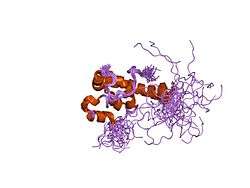PAIP2
Polyadenylate-binding protein-interacting protein 2 is a protein that in humans is encoded by the PAIP2 gene.[5][6][7]
Interactions
References
- 1 2 3 GRCh38: Ensembl release 89: ENSG00000120727 - Ensembl, May 2017
- 1 2 3 GRCm38: Ensembl release 89: ENSMUSG00000037058 - Ensembl, May 2017
- ↑ "Human PubMed Reference:".
- ↑ "Mouse PubMed Reference:".
- ↑ Khaleghpour K, Svitkin YV, Craig AW, DeMaria CT, Deo RC, Burley SK, Sonenberg N (Feb 2001). "Translational repression by a novel partner of human poly(A) binding protein, Paip2". Mol. Cell. 7 (1): 205–16. doi:10.1016/S1097-2765(01)00168-X. PMID 11172725.
- ↑ Berlanga JJ, Baass A, Sonenberg N (Jul 2006). "Regulation of poly(A) binding protein function in translation: Characterization of the Paip2 homolog, Paip2B". RNA. 12 (8): 1556–68. doi:10.1261/rna.106506. PMC 1524897. PMID 16804161.
- ↑ "Entrez Gene: PAIP2 poly(A) binding protein interacting protein 2".
- ↑ Khaleghpour K, Kahvejian A, De Crescenzo G, Roy G, Svitkin YV, Imataka H, O'Connor-McCourt M, Sonenberg N (Aug 2001). "Dual interactions of the translational repressor Paip2 with poly(A) binding protein". Mol. Cell. Biol. 21 (15): 5200–13. doi:10.1128/MCB.21.15.5200-5213.2001. PMC 87244. PMID 11438674.
Further reading
- Bonaldo MF, Lennon G, Soares MB (1996). "Normalization and subtraction: two approaches to facilitate gene discovery". Genome Res. 6 (9): 791–806. doi:10.1101/gr.6.9.791. PMID 8889548.
- Zhang QH, Ye M, Wu XY, Ren SX, Zhao M, Zhao CJ, Fu G, Shen Y, Fan HY, Lu G, Zhong M, Xu XR, Han ZG, Zhang JW, Tao J, Huang QH, Zhou J, Hu GX, Gu J, Chen SJ, Chen Z (2000). "Cloning and functional analysis of cDNAs with open reading frames for 300 previously undefined genes expressed in CD34+ hematopoietic stem/progenitor cells". Genome Res. 10 (10): 1546–60. doi:10.1101/gr.140200. PMC 310934. PMID 11042152.
- Hartley JL, Temple GF, Brasch MA (2000). "DNA cloning using in vitro site-specific recombination". Genome Res. 10 (11): 1788–95. doi:10.1101/gr.143000. PMC 310948. PMID 11076863.
- Wiemann S, Weil B, Wellenreuther R, Gassenhuber J, Glassl S, Ansorge W, Böcher M, Blöcker H, Bauersachs S, Blum H, Lauber J, Düsterhöft A, Beyer A, Köhrer K, Strack N, Mewes HW, Ottenwälder B, Obermaier B, Tampe J, Heubner D, Wambutt R, Korn B, Klein M, Poustka A (2001). "Toward a catalog of human genes and proteins: sequencing and analysis of 500 novel complete protein coding human cDNAs". Genome Res. 11 (3): 422–35. doi:10.1101/gr.GR1547R. PMC 311072. PMID 11230166.
- Kozlov G, Trempe JF, Khaleghpour K, Kahvejian A, Ekiel I, Gehring K (2001). "Structure and function of the C-terminal PABC domain of human poly(A)-binding protein". Proc. Natl. Acad. Sci. U.S.A. 98 (8): 4409–13. doi:10.1073/pnas.071024998. PMC 31848. PMID 11287632.
- Khaleghpour K, Kahvejian A, De Crescenzo G, Roy G, Svitkin YV, Imataka H, O'Connor-McCourt M, Sonenberg N (2001). "Dual interactions of the translational repressor Paip2 with poly(A) binding protein". Mol. Cell. Biol. 21 (15): 5200–13. doi:10.1128/MCB.21.15.5200-5213.2001. PMC 87244. PMID 11438674.
- Gouyon F, Onesto C, Dalet V, Pages G, Leturque A, Brot-Laroche E (2003). "Fructose modulates GLUT5 mRNA stability in differentiated Caco-2 cells: role of cAMP-signalling pathway and PABP (polyadenylated-binding protein)-interacting protein (Paip) 2". Biochem. J. 375 (Pt 1): 167–74. doi:10.1042/BJ20030661. PMC 1223656. PMID 12820898.
- Onesto C, Berra E, Grépin R, Pagès G (2004). "Poly(A)-binding protein-interacting protein 2, a strong regulator of vascular endothelial growth factor mRNA". J. Biol. Chem. 279 (33): 34217–26. doi:10.1074/jbc.M400219200. PMID 15175342.
- Wiemann S, Arlt D, Huber W, Wellenreuther R, Schleeger S, Mehrle A, Bechtel S, Sauermann M, Korf U, Pepperkok R, Sültmann H, Poustka A (2004). "From ORFeome to biology: a functional genomics pipeline". Genome Res. 14 (10B): 2136–44. doi:10.1101/gr.2576704. PMC 528930. PMID 15489336.
- Mehrle A, Rosenfelder H, Schupp I, del Val C, Arlt D, Hahne F, Bechtel S, Simpson J, Hofmann O, Hide W, Glatting KH, Huber W, Pepperkok R, Poustka A, Wiemann S (2006). "The LIFEdb database in 2006". Nucleic Acids Res. 34 (Database issue): D415–8. doi:10.1093/nar/gkj139. PMC 1347501. PMID 16381901.
- Yoshida M, Yoshida K, Kozlov G, Lim NS, De Crescenzo G, Pang Z, Berlanga JJ, Kahvejian A, Gehring K, Wing SS, Sonenberg N (2006). "Poly(A) binding protein (PABP) homeostasis is mediated by the stability of its inhibitor, Paip2". EMBO J. 25 (9): 1934–44. doi:10.1038/sj.emboj.7601079. PMC 1456944. PMID 16601676.
This article is issued from
Wikipedia.
The text is licensed under Creative Commons - Attribution - Sharealike.
Additional terms may apply for the media files.




